Flechtner F.M., Gruber Th., G?ntner A., Mandea M., Rothacher M., Sch?ne T., Wickert J. (Eds.) System Earth via Geodetic-Geophysical Space Techniques
Подождите немного. Документ загружается.

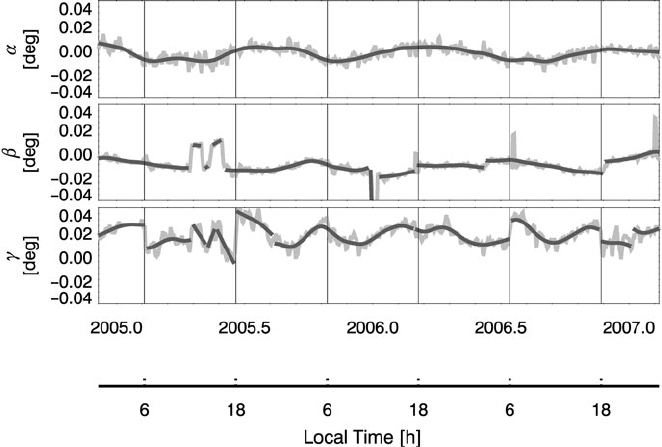
494 M. Mandea et al.
is to co-estimate the Euler angles between the FGM and ASC as part of the modeling
of the geomagnetic field. In an attempt to minimize the difference between magnetic
field readings and model predictions the three angles are treated as free parameters.
Small values for these angles can be considered in a closed loop validation of the
magnetic field data in NEC frame. Figure 12 shows a time series of obtained Euler
angle variations of the optical bench for 2005–2007. The three components describe
rotations around the roll, pitch and yaw axis. Variations of order ±0.001
◦
can be
observed, and particularly, the α and γ angles show variations synchronized with
local time. In this context it has to be noted that the estimation of Euler angles
assumes a magnetic field which can entirely be described by a scalar potential. For
measurements done into the ionosphere this is not strictly true. The synchronized
variations may therefore indicate that the violation of the assumptions is local time
dependent. There are several jumps in the bottom plot occurring just at dawn and
dusk. This behavior can be explained because only night time data are used for
the magnetic field modeling. When the satellite orbit passes the 06/18 local time
sector the considered data set is switched from ascending to descending or vice
versa. Obviously, the magnetic field data in the NEC frame are somewhat different
depending on the sampling direction from North to South or South to North.
The angle β shows also some s pikes and deviations. The narrow spikes could
be associated with time errors. At certain intervals the GPS receiver sees only 4–5
GPS satellites. This is not sufficient to generate a reliable time signal. In those cases
Fig. 12 Temporal variations over 2005–2007 of the co-estimated optical bench Euler angles: rota-
tions around the roll (top), pitch (middle) and yaw (bottom)axesareshown.Vertical lines mark the
crossings of the orbital plane through the 06 and 18 local time
The Earth’s Magnetic Field 495
the PPS is off by a fraction of a second. Such a time error has a similar effect as a
wrong pitch angle. Therefore, these spikes appear only in the β angle values. The
large negative excursion in the middle of the frame is associated with the leap second
at the beginning of 2006. Some of developed codes are obviously not able to handle
this situation correctly.
Figure 12 shows the result of Euler angles co-estimation when using a 3-day
interval for field modeling. The dark heavy line is a smooth piecewise fitted curve.
Angles derived from this later curve are used to improve the rotation from the FGM
to the ASC system. With this final update a set of reliable NEC data processed is
available. Finally, lets us stress that the undulations visible in Fig. 12 cannot be
interpreted directly as variations of the Euler angles. They are the sum of many
small imperfections of data from various instruments. Nevertheless, by applying
these corrections the final NEC magnetic field data quality is greatly improved.
2.6 Complementarity of the Ground and Satellite Data
Ideally, a dataset used in a global field modeling has to fulfill the following
requirements:
• samples should be taken at evenly distributed points, dense enough to cover the
shortest wavelengths,
• readings at different locations should be taken simultaneously,
• measurements should be made in areas free of electric currents, i.e. free of
sources of induced magnetic fields.
These three conditions could be satisfied by a dense ground-based network.
In reality, as shown before, the observatory network is not dense enough and
rather unevenly distributed. This weakness can be overcome by satellite measure-
ments. Using only magnetic field observations from space has, however, also its
short-comings. For example, the last two requirements can not be fulfilled by
a single satellite. Satellites take measurements sequentially orbit-by-orbit, and it
takes several days or even months to achieve an appropriate global coverage. In
order to compensate for this weakness temporal changes of the magnetic field dur-
ing the considered interval have to be corrected or co-estimated. Since satellites
orbit the Earth in the ionosphere, they cross various kinds of currents. For the
mitigation of this problem two procedures are possible: one is to remove the mag-
netic effects of these currents from the recorded data, and the second is to select
time intervals when the currents, which cannot be corrected, are sufficiently weak
(see below).
Spatial distribution. The distribution of magnetic observatories over the globe
(Fig. 13) is highly non-uniform. A possibility to counterbalance this uneven geo-
graphical distribution is the use of an adequate weighting scheme (Langlais and
Mandea, 2000). However, adequate weighting cannot make up for the lack of infor-
mation in the regions sparsely covered by data. Another possibility to improve our
knowledge of the secular variation is to have well-distributed global measurements
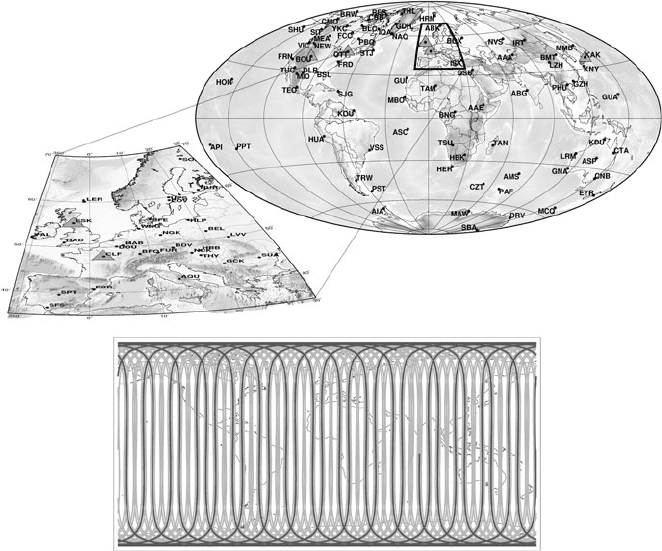
496 M. Mandea et al.
Fig. 13 Map of the INTERMAGNET magnetic observatory distribution (top). Coverage of the
Earth with CHAMP satellite magnetic data after 1 day DOY 288 2007 (black)and1week(DOY
226-232 2007) (grey, bottom)
from satellites. The data provided by each of the three satellites currently in orbit
ensure a good coverage of the Earth’s surface over a 4-month period. Figure 13
shows the orbit tracks for 1 day and for 1 week, respectively, for the CHAMP satel-
lite. The coverage over 1 week already appears sufficient for a good data distribution
in space, but this coverage is not sufficient in local time. Moreover, these plots are
based on all available measurements, without considering data quality and selection
criteria with respect to external disturbances.
Temporal coverage. The number of observatories providing hourly means or
1-minute data (INTERMAGNET observatories) is lower than the total number of
worldwide observatories. Nevertheless, they cover a large time-span when compar-
ing with the satellite missions. Figure 14 indicates the time-span covered by the
number of observatories providing different data, and also the short interval covered
by satellite missions.
Magnetic field measurements obtained by various platforms have their strengths
and weaknesses. By properly combining these data, information about the charac-
teristics of the geomagnetic field can be retrieved. This is shown in the following
sections.
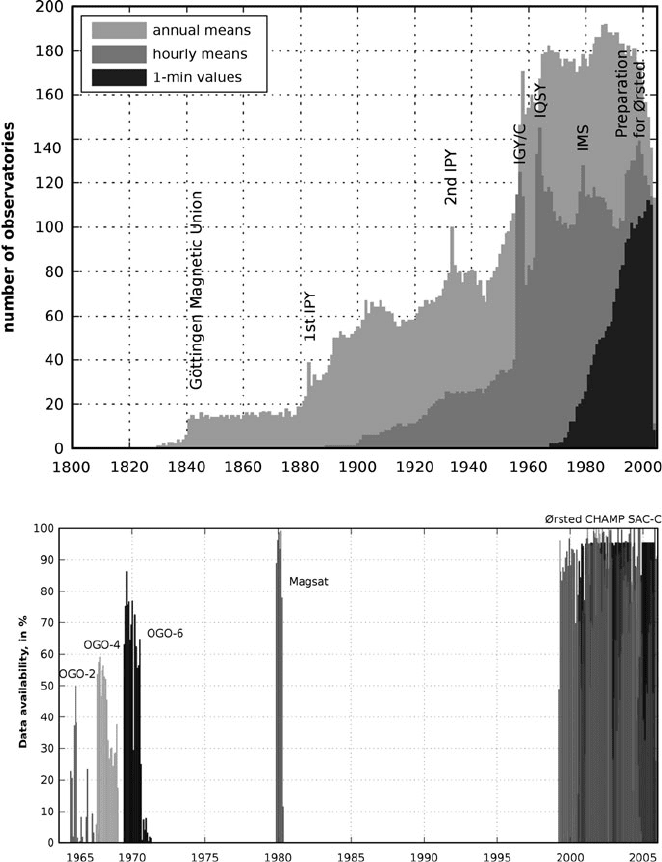
The Earth’s Magnetic Field 497
Fig. 14 Temporal distribution (in 2005) of the various kind of data provided by magnetic observa-
tories (top). Temporal distribution of the satellite missions carrying a scalar magnetometer (POGO
series) or a scalar and vector magnetometer (MAGSAT, Ørested, CHAMP, SAC-C)
3 Data and Field Modeling
An important prerequisite for deriving more precise and higher resolution models
of the geomagnetic field is the availability of high-quality measurements. Under the
assumption of suitable data the modeling task may be separated in a few crucial

498 M. Mandea et al.
steps. The first one is linked to data selection, as in each single measurement all
contributions exist, and the wish is to minimize the external ones. Thereafter, the
inversion of the measurements to obtain a mathematical description of the field
distribution is at a global or regional scale.
Before presenting in some more details a description of the geomagnetic field
produced by the lithosphere, we summarize the efforts needed in a good data
selection process, as well as the basis for the global and regional modeling.
3.1 Data Selection
3.1.1 Data Selection – General Needs
Before applying different techniques to available measurements, a selection of dif-
ferent datasets is needed. This process is generally different from one modeler to
another, however, the main idea is to minimize as much as possible the various exter-
nal contributions. For example, the GRIMM model
4
(Lesur et al., 2008), mainly
used in the following in magnetic field description, is built using exclusively vector
magnetic data. The main motivation for this choice is the need to use satellite mea-
surements during polar summers. Therefore, the fields generated by field aligned
currents and in the ionosphere have to be modeled at high latitudes, and this can be
achieved only if vector data are available at all local times.
GRIMM model covers the time span 2001–2005, when CHAMP vector data with
acceptable quality flag settings are available. Using two magnetic components only
lead to a robust model and it has the further advantage that there is no need to
model the field generated by the ring current. The CHAMP measurements have
been selected between ± 55
◦
magnetic latitudes such that
• IMF B
z
has positive values
• 20 s minimum separate two data points
• the local time (LT) is in between 23:00 and 05:00
• the sun is below the horizon up to 100 km above the Earth’s reference radius
• the VMD (Thomson and Lesur, 2007) norm is no larger than 20 nT and the norm
of its derivative is less than 100 nT/day.
At magnetic latitudes outside the ± 55
◦
interval, the three components of the
magnetic data vector are used. CHAMP data with acceptable quality flag settings
are selected for positive IMF B
z
values, with 20 s minimum between two data
points, a VMD norm no larger than 20 nT and the norm of its derivative is less
than 100 nT/day. The use of the full magnetic vector at all local times is necessary
for separating the field generated by field aligned currents or in the ionosphere from
the internal core field. Using the full vector data at high latitude also improves the
4
www.gfz-potsdam.de/magmodels/GRIMM
The Earth’s Magnetic Field 499
robustness of the low order internal Gauss coefficients, in the same way that vector
data are used at mid-latitudes to avoid the Backus effect in models built mainly from
scalar magnetic data.
GRIMM model is also based on observatory hourly mean values, selected
following the same criteria, as for the between ± 55
◦
magnetic latitudes.
3.1.2 Data Selection – New Approach
The new satellite era brings us in a situation when a large number of mag-
netic measurements has became available, due to the three magnetic missions,
Ørsted, CHAMP and SAC-C. The forthcoming ESA’s Swarm constellation mission,
scheduled for launch in 2011, will dramatically increase this number.
In this context, modeling t he magnetic potential field of the Earth becomes a chal-
lenging task with high demands on computer memory and time. As noted before,
for internal field modeling, the measurements are selected according to the quiet
geomagnetic conditions (geomagnetic indices, local time, etc). Nevertheless, the
number of data remains important. Often, the number of measurements, taken into
account in inversions, is simply reduced by decimating them. Such a “random selec-
tion” may obviously lead to loss of information. In addition, not only the satellite
data, but also surface data have been considered. High resolution field modeling,
at global or regional scales, indeed requires to combine the “medium” resolution
satellite measurements with very dense surface datasets comprising ground-based,
airborne and marine measurements. This increases considerably the size of the
datasets from which the potential field models are computed.
To overcome these possible drawbacks, it appears necessary to develop tech-
niques to deal with these large amounts of data. Recently, two important aspects
have been considered: firstly, the data have to be preprocessed in a compact and
reasonable way, secondly, the design of the model and the inversion scheme have
to allow fast and local computations. Thus, Minchev et al. (2009) have proposed
to take advantage of: (i) the rather smooth behavior of the internal magnetic field at
satellite altitude and (ii) the mathematical and geometrical properties of the wavelets
frames (see below), which can be used as a modeling technique. In this context, local
multipole approximations of the wavelets at satellite altitude, have been developed.
To cope with the large number of satellite measurements, and in particular with
some 300 millions of measurements, from the upcoming 4-year Swarm multisatel-
lite mission, methods have been developed to avoid the storage of large normal
matrices needed for a large number of spherical harmonics. Those methods are
based on the iterative approach (see for instance Kusche, 2000; Schuh, 2000; Keller,
2001). They make use of a matrix that is representative of the normal system, but
easier to compute. Such matrix allows to compute an approximate solution of the
normal system, that is iteratively refined. It can also be used as a pre-conditioner of
the normal system, allowing to speed-up convergence rates of iterative solvers.
In Minchev et al. (2009) the space-domain is decomposed, i.e. a shell at satellite
altitude is defined by the measurement positions, into a sum of geometrical 3D-
bodies (triangular prisms). Each unity-volume contains a certain amount of field
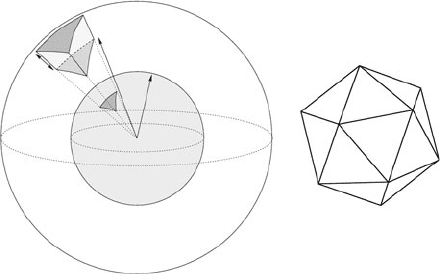
500 M. Mandea et al.
measurement points. As soon as the considered unity-volume is small enough, the
data are located in the vicinity of each other and the field itself appears smooth. In
the inverse problem, the expansion of the related magnetic field in wavelets frames
may be replaced by a power series of local multipole developments around the centre
of mass of the data positions inside the defined volume. In this way, a piecewise
decomposition of the magnetic field is obtained, at satellite altitude. The coefficients
of each local development may then be used in global field modeling. Let us describe
in more detail the space discretization at the satellite level.
The space, where the satellites revolve, is considered as a shell. Its thickness is
directly defined by the range of radius of the considered data positions according to
geocentric coordinate system. This shell is discretize to K number of unity-volumes
P
j
(with j=1,...,K) equivalent to the number of facets of an icosahedron centered
onto the Earth (Chambodut et al., 2005).
Each unity-volume P
j
is defined such that it gets property of compact geometry:
its thickness is chosen to be more or less equivalent to the size of the icosahedron
edges at the satellite altitude. If the thickness of the shell defined by the data is large,
another layer of unity volume is added in the radial direction. The aim is to obtain
unity-volumes with reasonable shapes, neither flat thin shells, nor long thin radial
columns, as shown in Fig. 15.
For a given dataset, the balance should be determined between the number
of unity-volume K (directly related to their size), the number of data per unity-
volume M
j
(with j=1,...,K) and the degree of multipole expansion inside a prism
(Chambodut et al., 2005). For example, in case of a few data in a large unity-volume,
this configuration may allow recovery of large wavelengths potential field, and thus
leads to the use of low degree polynomials. At the contrary, in case of a large number
of data in a small unity-volume, this configuration may allow recovery of smaller
wavelengths potential field, and thus leads to the use of higher degree polynomials.
A crucial question regarding the use of the multi-polar expansion technique
arises. Depending on the size of the considered dataset, how the size of the
Fig. 15 A unity-volume at satellite altitude (left); the simplest icosahedron – 20 faces (right)
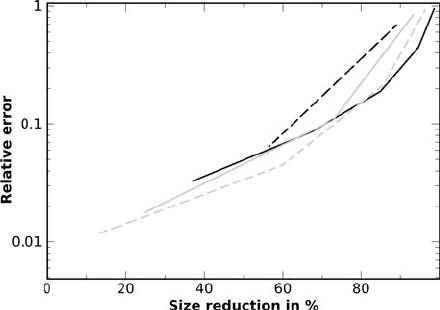
The Earth’s Magnetic Field 501
unity-volumes (the number of data per unity-volume) and the maximal order of
the local harmonic polynomials have to be chosen. This choice has to be done
to obtain optimal performances. It is clear that the higher the resolution of the
space discretization is, the better the approximation will be. On the other hand,
the maximal reduction of the size of the underlying problem, is obtained for the
lowest possible resolution. Therefore, it is needed to find a balance between the
resolution of the space discretization and the degree of the local expansion used in
the model.
Figure 16, shows the maximum relative error between all spherical harmonics up
to degree 30 and their corresponding local multi-polar approximations, versus the
ratio (in %) between the sizes of the underlying and the approximated problems (size
reduction), for a given dataset. For small and moderate size datasets, low orders local
approximations, of first (L = 4) and second (L = 9) orders, are preferable. Higher
order approximations would be beneficial, when a dataset is large enough, so the
number of local coefficients per unity-volume can be compensated by the amount
of data approximated in each cell.
In Minchev et al. (2009) two cases have been investigated, for the gravity and
magnetic field. It has been shown that depending on the chosen precision of the
approximation, the speed and the quality of the inversion can practically be con-
trolled. Thus, fast quick-look solutions or highly precise models can be computed
with a great deal of flexibility. The performed tests have also shown that the amount
of errors introduced by approximations in models can be controlled. Distortions are
small, and become negligible when the process is iterated. This new method can
be applied to any kind of modeling functions like wavelets or other radial basis
functions.
Fig. 16 Ratio in % between the sizes of the original and the approximated problems versus the
approximation relative error for L = 4(black), L = 9(dashed grey), L = 16 (grey), L = 25 (dashed
black)

502 M. Mandea et al.
3.2 Global Modeling
The most commonly employed global method to represent the geomagnetic field
is the Spherical Harmonic Analysis (SHA). In a space defined by three spherical
coordinates (r, θ, φ), the geomagnetic induction field B can be expressed as
B =−∇V (13)
where V is a scalar potential satisfying V=0.
At the Earth’s surface this potential can be expressed as the sum:
V = V
i
+ V
e
(14)
where V
i
and V
e
represent the internal and external scalar potential, respectively.
In spherical coordinates equation V=0 can be written as
∂
∂r
r
2
∂V
∂r
+
1
r
2
sin θ
∂
∂θ
sin θ
∂V
∂θ
+
1
r
2
sin
2
θ
∂
2
V
∂φ
2
− 0 (15)
and it is solved by separation of variables and then expanded into a s pherical
harmonic series (see below).
Harmonics are widely used in mathematics and physics to represent complex,
usually natural, functions. These harmonics are periodic functions of varying ampli-
tude and period. The more harmonics are used, the closer the approximation to
reality is.
In the absence of magnetic sources, the geomagnetic field can be presented as
the negative gradient of a potential: B
p
= –V(θ ,φ,ρ,τ ). The source of this poloidal
field can be from internal or from external origin and the associated potentials, V
i
and V
e
respectively, are described on a spherical surface. Following (Gauss, 1839),
the two potentials V
i
and V
e
can be developed as spherical harmonic expansions:
V
i
(θ, φ,r,t) − a
l,m
a
r
l+1
g
m
l
(t)Y
m
l
(θ, φ) (16)
V
e
(θ, φ,r,t) − a
l,m
r
a
l
q
m
l
(t)Y
m
l
(θ, φ) (17)
where θ and φ are the colatitude and longitude, a =6,371.2 km is a reference radius,
Y
l
m
(θ,φ) are the usual Schmidt normalized spherical harmonic (SH) functions and
g
l
m
(t), q
l
m
(t) are the Gauss coefficients. The convention used here is t hat negative
orders (m < 0) are associated with sin(mφ) terms, whereas zero or positive orders
(m ≥ 0) are associated with cos(mφ).
Traditionally, the North, East, Vertical down system of coordinates is used to give
the expression of the gradient of the potential. Here, as for the GRIMM model, the
geocentric Cartesian system of coordinates is used. The direction Z of the geocentric
Cartesian system of coordinates (i.e. ≈ the Earth’s rotation axis) is considered, first.
Also, it is assumed that an optimal distribution of vector data at satellite altitude

The Earth’s Magnetic Field 503
is available, such that a magnetic field model can be robustly built. The data set is
made of the Z component of the measured magnetic field. The magnetic field of
external origin in this Z direction is given by:
B
e
pZ
=−cos θ · ∂
r
V
e
(θ, φ,r,t) + sin θ ·
1
r
∂
θ
V
e
(θ, φ,r,t) (18)
which leads to:
B
e
pZ
=−
L
l=1
l
m=−1
r
a
l−1
q
m
l
(t)
'
(l +|m|)(l −|m|)Y
m
l−1
(θ, φ) (19)
The external field is generally assumed to be large scale and generated mainly
in the magnetosphere which justify the use of L = 2 as the maximum SH degree.
Considering only the first degree (l = 1), only the order m = 0 appears and therefore
only the SH function Y
0
0
(cos θ) is involved. This function is a constant in space, so,
as expected, the large scale external field along the Z direction (i.e. associated with
q
1
0
) is a constant in space. The field of internal origin is given by:
B
i
pZ
=−
L
l=1
l
m=−1
a
r
l+2
g
m
l
(t)
'
(l +|m|+1)(l −|m|+1)Y
m
l+1
(θ, φ) (20)
In this equation for a given degree l the SH function is Y
l+1
m
(θ, φ) whereas it was
Y
l–1
m
(θ, φ) in the expression 19 of the external field. If the maximum SH degree
L = 2 is and acceptable approximation for the external field, the SH function of
the highest degree in equation 19 is Y
1
m
(θ) whereas in Eq. (20) the SH function of
the minimum degree is Y
2
m
(θ, φ). Therefore using only the distribution of Z data
described above leads to a separation of the internal and external field contributions
to the magnetic field. It leads also to a unique set of Gauss coefficients. However,
for a better accuracy one of the two other directions can be used. The expressions
for the internal poloidal field in the X and Y directions are:
B
i
pX
=−
1
2
L
l=1
a
r
l+2
!
√
(l +1)(l + 2)g
0
l
(t)Y
1
l+1
(θ, φ)
+
l
m=1
√
(l +m + 1)(l + m + 2)(g
m
l
(t)Y
m+1
l+1
(θ, φ) + g
−m
l
(t)Y
−m−1
l+1
(θ, φ))
−
l
m=1
√
(l −m + 1)(l − m + 2)(g
m
l
(t)Y
m−1
l+1
(θ, φ) + g
−m
l
(t)Y
−m+1
l+1
(θ, φ))
(
(21)
B
i
pY
=−
1
2
L
l=1
a
r
l+2
)
√
(l +1)(l + 2)g
0
l
(t)Y
−1
l+1
(θ, φ)
+
l
m=1
√
(l +m + 1)(l + m + 2)(g
m
l
(t)Y
−m−1
l+1
(θ, φ) + g
−m
l
(t)Y
m+1
l+1
(θ, φ))
−
l
m=1
√
(l −m + 1)(l − m + 2)(g
m
l
(t)Y
−m+1
l+1
(θ, φ) + g
−m
l
(t)Y
m+1
l+1
(θ, φ))
(
(22)
Over the polar regions, the vector satellite data are strongly contaminated by the
field generated by field aligned currents (FAC). At satellite altitude part of this field
is toroidal and is given by: B
t
= –η ×∇
s
(θ,φ,t) where η is the unit vector in the
